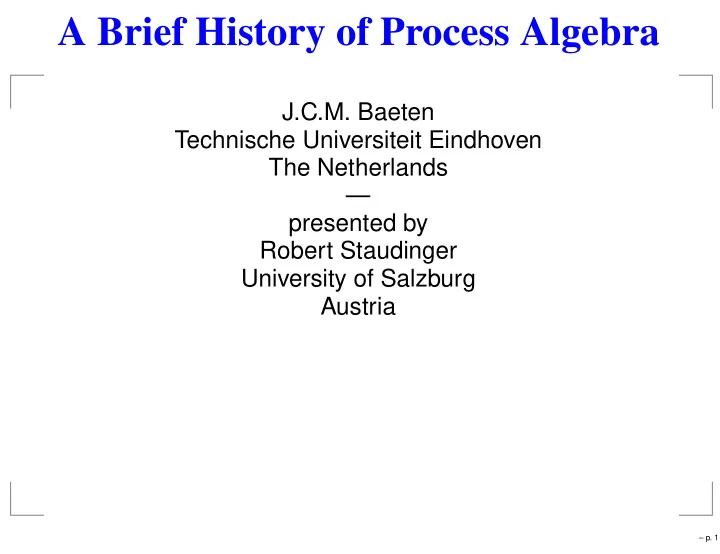

A Brief History of Process Algebra J.C.M. Baeten Technische Universiteit Eindhoven The Netherlands — presented by Robert Staudinger University of Salzburg Austria – p. 1
Introduction What is Process Algebra? History, most important algebras Recent developments – p. 2
What is Process Algebra? (1) Roots in automata theory (states, transitions) Equivalence: language equivalence Algebra: regular expressions ∗ Lacking in concurrency and interaction Process: behaviour of a system P . algebra: axiomatic approach to describe processes ∗ Axioms allow for calculations Equivalence: bisimilarity – p. 3
What is Process Algebra? (2) Basic operators + alternative composition (weakest binding) || parallel composition ; sequential composition (strongest binding) Operator syntax differs among algebras – p. 4
What is Process Algebra? (3) Basic laws x + y = y + x (commutativity) x + ( y + z ) = ( x + y ) + z (associativity: alternative) x + x = x (idempotency) ( x + y ); z = x ; z + y ; z (right distributivity of + over ;) ( x ; y ); z = x ; ( y ; z ) (associativity: sequential) xy = yx (commutativity of parallel composition) ( xy ) z = x ( yz ) (associativity: parallel) Interleaving vs. true concurrency systems (expansion theorem) – p. 5
History 1. Operational semantics (McCarthy) Computer: abstract machine State: variables Transition: elementary program instruction 2. Denotational semantics (Scott, Strachey) More abstract Program model is function turning input into output 3. Axiomatic semantics (Floyd, Hoare) Emphasis on proving programs correct Proof triple: precondition, statement, postcondition ∗ – p. 6
History: Bekiˇ c First to address semantics of quasi-parallel execution ( A//B ) ξ = ( cases Aξ : null − → Bξ ( f, A ′ ) − → f, ( A ′ //B )) ⊔ ( cases Bξ : null − → Aξ ( g, B ′ ) − → g, ( A//B ′ )) – p. 7
History: CCS Calculus of Communicating Systems Robin Milner, central person on PA Uses * for sequential, ? for alternative, || for parallel composition Fomulates basic CCS with Henessy Observational- and strong equivalence defined inductively Henessy-Milner logic: logical characterisation of process equivalence – p. 8
History: CSP Communicating Sequential Processes Tony Hoare, now at MSR First to introduce message passing instead of global variables * Prevents deadlocks, influenced Milner/CCS – p. 9
? History: ACP Algebra of Communicating Processes Bergstra, Klop, 1982 First to use term process algebra Axioms ( + union, · composition, � left merge) x + y = y + x x + ( y + z ) = ( x + y ) + z x + x = x ( xy ) z = x ( yz ) ( x + y ) z = xz + yz ( x + y ) � z = x � z + y � z ax � y = a ( x � y + y � x ) a � y = ay – p. 10
Developments: Theory Bisimulation is central notion of equivalence in PA. Def: (Strong Bisimulation) A binary relation R over the set of states s i ∈ S of an LTS is a bisimulation iff whenever s 1 R s 2 and α is an action: α α → s ′ → s ′ 2 such that s ′ 1 R s ′ If s 1 1 , then ∃ a transition s 2 2 α α → s ′ → s ′ 1 such that s ′ 1 R s ′ If s 2 2 , then ∃ a transition s 1 2 Two bisimilar states are written s 1 ∼ s 2 Operational semantics of CCS given in terms of LTS whose states are process expression: definition applies. – p. 11
Developments: Time Variants of CCS, CSP , ACP with quantitative notion of time Formulations of bisimulation taking time into account Used e.g. in protocol verification Very strict, notion of approximation desireable – p. 12
Developments: Mobility Networks of mobile processes are being researched Examples: π calculus, ambient calculus Interesting area to watch, e.g. recent submission of save boxed ambient calculus implementation to DATE Is a VM for executing processes on networks, according to a behavioural spec in highlevel syntax – p. 13
Conclusion Early work focused on programming languages, parallel constructs Breakthrough 1: from process as function to provision for intermediate states Breakthrough 2: replacement of global state with message passing PAs extended with data, time, mobility, probability, stochastics over time Yet challenges exist, would lead too far, get in touch with Ana – p. 14
Recommend
More recommend